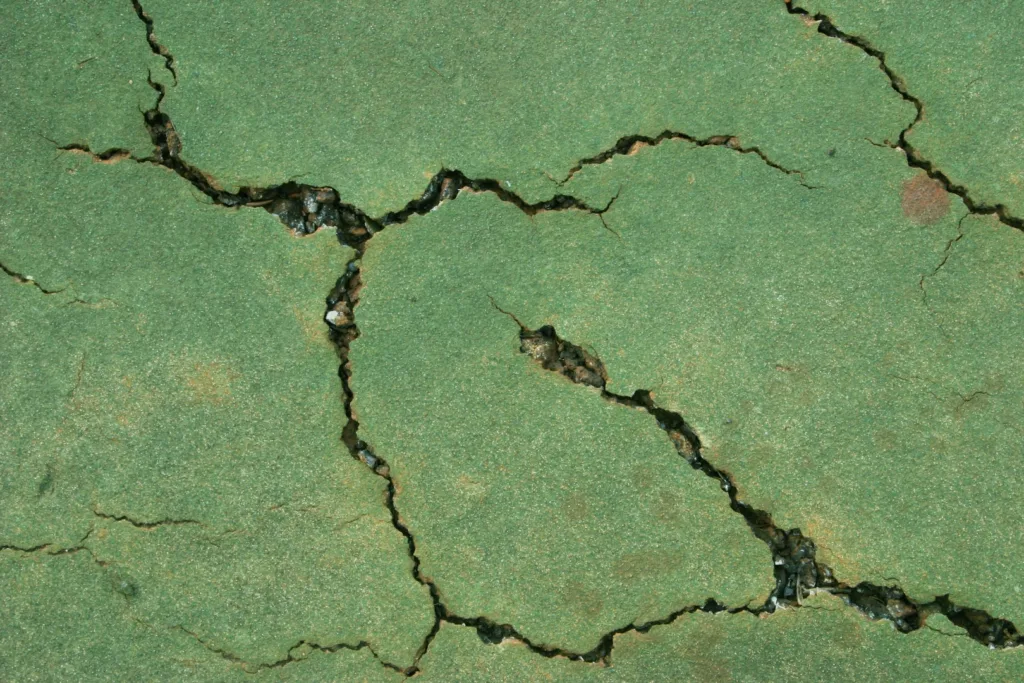
If you’ve recently filled cracks on your court, you may be wondering how long the repair will last or, more importantly, if they will open back up. Eventually, they will reappear, but that doesn’t mean your repair was a waste. Here’s what you need to know about the integrity of courts.
Why Do Court Cracks Happen?
Outdoor courts can develop cracks over time from weather, poor construction, maintenance, or simply from age. Asphalt and concrete courts are particularly susceptible to developing cracks, though all courts will become damaged from normal wear and tear.
Temperature Fluctuations — Your court will expand in hot temperatures and contract in cold temperatures, putting stress on your court surface and leading to cracks.
Water Damage — If water seeps into your court, it can freeze and expand, leading to cracks or further widening cracks you may already have.
Poor Construction — If your court has been inadequately installed, has an improper base compaction, or is made of incorrect materials, it can develop cracks.
Lack of Maintenance — Neglecting regular maintenance, such as filling cracks, can allow them to worsen and become more difficult to repair.
Types of Cracks
There are a few different types of cracks that can appear on your court, including:
Hairline Cracks — These cracks are thin and shallow and may become worse over time.
Structural Cracks — These cracks are wider and deeper and often extend through the entire surface and into the base. They could also indicate underlying issues with the foundation of your court.
Spider Web Cracks — You can identify these cracks by their interconnected pattern. They are caused by a lot of surface movement or poor drainage.
Expansion Joint Cracks — These cracks occur along expansion joints, which are created intentionally to allow the court to constrict and expand due to temperature.
The Purpose of Crack Filling
Crack filling plays a crucial role in maintaining the integrity of your court. It:
Prevents Water Damage — Filled cracks prevent water from seeping into the base of your court, causing it to loosen and expand during freeze-thaw cycles and leading to more cracks and damage.
Extends the Court’s Lifespan — Filled cracks extend the life of your court and prevent larger issues that could require costly resurfacing.
Provides Safety — Cracks can lead to an uneven playing surface, so it’s important to fill them to maintain an even surface and prevent players from injuring themselves.
However, you should note that most crack repair methods are done to prevent bigger issues and improve the appearance of your court. Filled cracks are not permanent.

Will the Cracks Reappear?
In most cases, the cracks you fill will reappear eventually, especially in climates with freeze-thaw cycles. Crack fillers are flexible and designed to move with the court — but they’re not permanent. Over time, the filled ones may:
- Widen or shift due to seasonal expansion and contraction.
- Reopen due to underlying movement or structural issues.
- Show through resurfacing materials as “ghost cracks.”
Most filled cracks come back as hairline cracks, which, as noted, aren’t of immediate concern, but should be fixed to maintain the integrity of your court or for aesthetics.
How Long Do Crack Repairs Last?
How long filled cracks last depends on:
- The quality of the original court construction.
- The type of filler used.
- The severity and location of the cracks.
- Climate and ground conditions.
Some repairs may hold for up to 15 years, while others may show signs of re-cracking within a season or a couple of years.
What Can You Do to Minimize Recurring Cracks?
Routine Maintenance — Regularly sweep leaves, twigs, and other debris off your court and clean with a mild detergent and a mop or the soft-wash setting on your power washer. Check your court’s drainage and make sure to remove standing water as soon as possible.
Crack Monitoring — Monitor your court for any signs of damage, such as cracks or peeling, and address them promptly.

Re-Coating & Resurfacing — You should resurface your court every four to eight years to preserve the surface and hide minor imperfections. Considering adding a protective sealant or wax to enhance durability.
Reconstruction — If you notice widespread and persistent cracks, it might be time to consider a full rebuild with a crack-resistant system.
While Not Permanent, Filling Cracks Is Important
Crack filling is an essential part of court maintenance, even though it’s not a permanent solution. The goal is to prevent major issues, improve safety, and buy time — not to stop cracks forever. Remember, all maintenance is important if you want to ensure your court stays in good shape for as long as possible.


